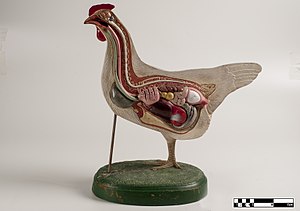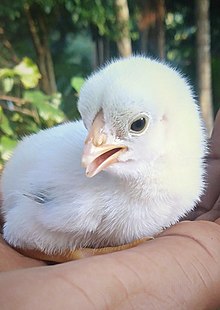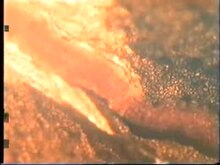An application of game theory.
Political conflicts arise which are analogous to the game of chicken in which two contestants will, for instance, drive towards each other in motor cars. If both hold their course, both will crash. The one who saves herself, and so her opponent, is the ‘chicken’.
As in other ‘games’, the action of each participant is seen to be dependent in part on their estimate of the likely behavior of the other.
The Cuban missile crisis of 1962 is often described in these terms.
Source:
Robert Abrams, Foundations of Political Analysis (New York, 1979)
Terminology

Didactic model of a chicken.
In the UK and Ireland, adult male chickens over the age of one year are primarily known as cocks, whereas in the United States, Canada, Australia and New Zealand, they are more commonly called roosters. Males less than a year old are cockerels.[10] Castrated or neutered roosters are called capons (surgical and chemical castration are now illegal in some parts of the world). Females over a year old are known as hens, and younger females as pullets,[11] although in the egg-laying industry, a pullet becomes a hen when she begins to lay eggs, at 16 to 20 weeks of age. The young are called chicks. In Australia and New Zealand (also sometimes in Britain), there is a generic term chook /tʃʊk/ to describe all ages and both sexes.[12]
Chicken originally referred to young domestic fowl.[13] The species as a whole was then called domestic fowl, or just fowl. This use of chicken survives in the phrase Hen and Chickens, sometimes used as a British public house or theatre name, and to name groups of one large and many small rocks or islands in the sea . The hen and chickens was also a name for the pentacycle, an early design of cargo cycle which had a large central driving wheel surrounded by four small stabiliser wheels.
In the Deep South of the United States, chickens are referred to by the slang term yardbird.[14]
General biology and habitat



Chickens are omnivores.[15] In the wild, they often scratch at the soil to search for seeds, insects and even animals as large as lizards, small snakes,[16] or young mice.[17]
The average chicken may live for five to ten years, depending on the breed.[18] The world’s oldest known chicken was a hen which died of heart failure at the age of 16 years according to the Guinness World Records.[19]
Roosters can usually be differentiated from hens by their striking plumage of long flowing tails and shiny, pointed feathers on their necks (hackles) and backs (saddle), which are typically of brighter, bolder colours than those of females of the same breed. However, in some breeds, such as the Sebright chicken, the rooster has only slightly pointed neck feathers, the same colour as the hen’s. The identification can be made by looking at the comb, or eventually from the development of spurs on the male’s legs (in a few breeds and in certain hybrids, the male and female chicks may be differentiated by colour). Adult chickens have a fleshy crest on their heads called a comb, or cockscomb, and hanging flaps of skin either side under their beaks called wattles. Collectively, these and other fleshy protuberances on the head and throat are called caruncles. Both the adult male and female have wattles and combs, but in most breeds these are more prominent in males. A muff or beard is a mutation found in several chicken breeds which causes extra feathering under the chicken’s face, giving the appearance of a beard. Domestic chickens are not capable of long distance flight, although lighter chickens are generally capable of flying for short distances, such as over fences or into trees (where they would naturally roost). Chickens may occasionally fly briefly to explore their surroundings, but generally do so only to flee perceived danger.
Behavior
Social behaviour

Hen with chicks, India.

Hen with chicks, Portugal.
Chickens are gregarious birds and live together in flocks. They have a communal approach to the incubation of eggs and raising of young. Individual chickens in a flock will dominate others, establishing a “pecking order”, with dominant individuals having priority for food access and nesting locations. Removing hens or roosters from a flock causes a temporary disruption to this social order until a new pecking order is established. Adding hens, especially younger birds, to an existing flock can lead to fighting and injury.[20] When a rooster finds food, he may call other chickens to eat first. He does this by clucking in a high pitch as well as picking up and dropping the food. This behaviour may also be observed in mother hens to call their chicks and encourage them to eat.
A rooster’s crowing is a loud and sometimes shrill call and sends a territorial signal to other roosters.[21] However, roosters may also crow in response to sudden disturbances within their surroundings. Hens cluck loudly after laying an egg, and also to call their chicks. Chickens also give different warning calls when they sense a predator approaching from the air or on the ground.[22]
Courtship
To initiate courting, some roosters may dance in a circle around or near a hen (“a circle dance”), often lowering the wing which is closest to the hen.[23] The dance triggers a response in the hen[23] and when she responds to his “call”, the rooster may mount the hen and proceed with the mating.
More specifically, mating typically involves the following sequence: 1. Male approaching the hen. 2. Male pre-copulatory waltzing. 3. Male waltzing. 4. Female crouching (receptive posture) or stepping aside or running away (if unwilling to copulate). 5. Male mounting. 6. Male treading with both feet on hen’s back. 7. Male tail bending (following successful copulation).[24]
Nesting and laying behaviour

Chicken eggs vary in colour depending on the breed, and sometimes, the hen, typically ranging from bright white to shades of brown and even blue, green, light pinkish and recently reported purple (found in South Asia) (Araucana varieties).

Chicks before their first outing
Hens will often try to lay in nests that already contain eggs and have been known to move eggs from neighbouring nests into their own. The result of this behaviour is that a flock will use only a few preferred locations, rather than having a different nest for every bird. Hens will often express a preference to lay in the same location. It is not unknown for two (or more) hens to try to share the same nest at the same time. If the nest is small, or one of the hens is particularly determined, this may result in chickens trying to lay on top of each other. There is evidence that individual hens prefer to be either solitary or gregarious nesters.[25]

A chick sitting in a person’s hand
Broodiness
Under natural conditions, most birds lay only until a clutch is complete, and they will then incubate all the eggs. Hens are then said to “go broody”. The broody hen will stop laying and instead will focus on the incubation of the eggs (a full clutch is usually about 12 eggs). She will “sit” or “set” on the nest, protesting or pecking in defense if disturbed or removed, and she will rarely leave the nest to eat, drink, or dust-bathe. While brooding, the hen maintains the nest at a constant temperature and humidity, as well as turning the eggs regularly during the first part of the incubation. To stimulate broodiness, owners may place several artificial eggs in the nest. To discourage it, they may place the hen in an elevated cage with an open wire floor.[citation needed]

Skull of a three-week-old chicken. Here the opisthotic bone appears in the occipital region, as in the adult Chelonian. bo = Basi-occipital, bt = Basi-temporal, eo = Opisthotic, f = Frontal, fm = Foramen magnum, fo = Fontanella, oc = Occipital condyle, op = Opisthotic, p = Parietal, pf = Post-frontal, sc = Sinus canal in supra-occipital, so = Supra-occpital, sq = Squamosal, 8 = Exit of vagus nerve.
Breeds artificially developed for egg production rarely go broody, and those that do often stop part-way through the incubation. However, other breeds, such as the Cochin, Cornish and Silkie, do regularly go broody, and they make excellent mothers, not only for chicken eggs but also for those of other species — even those with much smaller or larger eggs and different incubation periods, such as quail, pheasants, ducks, turkeys, or geese.
Hatching and early life
Fertile chicken eggs hatch at the end of the incubation period, about 21 days.[23] Development of the chick starts only when incubation begins, so all chicks hatch within a day or two of each other, despite perhaps being laid over a period of two weeks or so. Before hatching, the hen can hear the chicks peeping inside the eggs, and will gently cluck to stimulate them to break out of their shells. The chick begins by “pipping”; pecking a breathing hole with its egg tooth towards the blunt end of the egg, usually on the upper side. The chick then rests for some hours, absorbing the remaining egg yolk and withdrawing the blood supply from the membrane beneath the shell (used earlier for breathing through the shell). The chick then enlarges the hole, gradually turning round as it goes, and eventually severing the blunt end of the shell completely to make a lid. The chick crawls out of the remaining shell, and the wet down dries out in the warmth of the nest.
Hens usually remain on the nest for about two days after the first chick hatches, and during this time the newly hatched chicks feed by absorbing the internal yolk sac. Some breeds sometimes start eating cracked eggs, which can become habitual.[26] Hens fiercely guard their chicks, and brood them when necessary to keep them warm, at first often returning to the nest at night. She leads them to food and water and will call them toward edible items, but seldom feeds them directly. She continues to care for them until they are several weeks old.
Defensive behaviour
Chickens may occasionally gang up on a weak or inexperienced predator. At least one credible report exists of a young fox killed by hens.[27][28][29] A group of hens have been recorded in attacking a hawk that had entered their coop.[30]
Embryology

Earliest gestation stages and blood circulation of a chicken embryo
Chicken embryos have long been used as model systems to study developing embryos. Large numbers of embryos can be provided by commercial chicken farmers who sell fertilized eggs which can be easily opened and used to observe the developing embryo. Equally important, embryologists can carry out experiments on such embryos, close the egg again and study the effect later on. For instance, many important discoveries in the area of limb development have been made using chicken embryos, such as the discovery of the apical ectodermal ridge (AER) and the zone of polarizing activity (ZPA) by John W. Saunders.[31]
In 2006, scientists researching the ancestry of birds “turned on” a chicken recessive gene, talpid2, and found that the embryo jaws initiated formation of teeth, like those found in ancient bird fossils. John Fallon, the overseer of the project, stated that chickens have “…retained the ability to make teeth, under certain conditions… .”[32]
Genetics and genomics
Given its eminent role in farming, meat production, but also research, the house chicken was the first bird genome to be sequenced.[33] At 1.21 Gb, the chicken genome is considerably smaller than other vertebrate genomes, such as the human genome (3 Gb). The final gene set contained 26,640 genes (including noncoding genes and pseudogenes), with a total of 19,119 protein-coding genes in annotation release 103 (2017), a similar number of protein-coding genes as in the human genome.[34]
Physiology
Populations of chickens from high altitude regions like Tibet have special physiological adaptations that result in a higher hatching rate in low oxygen environments. When eggs are placed in a hypoxic environment, chicken embryos from these populations express much more hemoglobin than embryos from other chicken populations. This hemoglobin also has a greater affinity for oxygen, allowing hemoglobin to bind to oxygen more readily.

Hi there, simply was aware of your blog through Google, and found that it is truly informative. I am gonna be careful for brussels. I will appreciate if you happen to continue this in future. Lots of other people will probably be benefited from your writing. Cheers!
I got what you intend, thanks for posting.Woh I am glad to find this website through google.